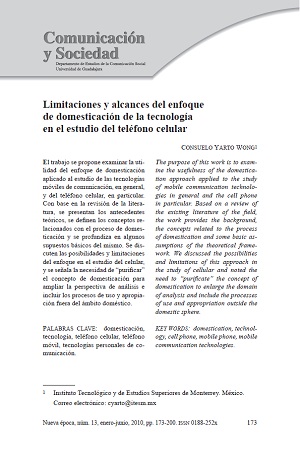Limitaciones y alcances del enfoque de domesticación de la tecnología en el estudio del teléfono celular
DOI:
https://doi.org/10.32870/cys.v0i13.1575Palabras clave:
domesticación, tecnología, teléfono celular, teléfono móvil, tecnologías personales de comunicaciónResumen
El trabajo se propone examinar la utilidad del enfoque de domesticación aplicado al estudio de las tecnologías móviles de comunicación, en general, y del teléfono celular, en particular. Con base en la revisión de la literatura, se presentan los antecedentes teóricos, se definen los conceptos relacionados con el proceso de domesticación y se profundiza en algunos supuestos básicos del mismo. Se dis cuten las posibilidades y limitaciones del enfoque en el estudio del celular, y se señala la necesidad de "purificar" el concepto de domesticación para ampliar la perspectiva de análisis e incluir los procesos de uso y apropiación fuera del ámbito doméstico.Descargas
Citas
Bakardjieva, M. (2006). Domestication running wild. From the moral economy of the household to the mores of a culture. En T. Berker, M. Hartmann, Y. Punie & K. Ward (Eds.), Domestication of media and technology (pp. 62–79). Berkshire: Open University Press.
Berker, T., Hartmann, M., Punie Y. & Ward, K. (2006). Introduction. En T. Berker, M. Hartmann, Y. Punie & K. Ward (Eds.), Domestication of media and technology (pp.1–17). Berkshire: Open University Press.
Castells, M., Fernández–Ardevol, M., Linchuan, J. & Sey, A. (2007). Mobile communication and society. A global perspective. Cambridge: The MIT Press.
Fortunati, L. (2002). Italy: stereotypes, true and false. En J. E. Katz & M. Aakhus (Eds.), Perpetual contact: Mobile communication, private talk, public performance (pp. 42–62). Cambridge UK: Cambridge University Press.
Fortunati, L. & Magnanelli, A. (2002). Young people and the mobile telephone. Revista de Estudios de Juventud, 57, 59–78. Recuperado en abril 15 de 2007 de la página de la Unión Internacional de Telecomunicaciones.
Fortunati, L. (2006). User Design and the Democratization of the Mobile Phone. First Monday, 11 (7). Recuperado en septiembre 8 de 2008 de la página de la publicación FirstMonday.
Gesser, H. (2005). Is the cell phone undermining the social order? Understanding mobile technology from a sociological perspective. En P. Glotz, S. Bertschi & C. Locke (Eds.), Tumb Culture. The meanings of mobile phones for society technology (pp. 23–35). Bielefeld: Transcript.
Giddens, A. (2004). Consecuencias de la modernidad (tercera reimpresión). Madrid: Alianza Editorial.
Haddon, L. & Silverstone, R. (1993). Teleworking in the 1990s. A view from the home. SPRU/CICT Report No. 10, University of Sussex. Recuperado en enero 9 de 2007 de la página Media@lse, del Departamento de Comunicación y Medios de la LSE.
Haddon, L. & Silverstone, R. (1994). Lone parents and their information and Communications Technologies.SPRU/CICT Report, No. 12, University of Sussex, Recuperado en enero 9 de 2007, de la página Media@lse, del Departamento de Comunicación y Medios de la LSE.
Haddon, L. & Silverstone, R. (1996). Information and Communication Technologies and the Young Elderly.Reporte ESRC/PICT. Recuperado enero 7 de 2007 de la página Media@lse, del Departamento de Comunicación y Medios de la LSE.
Haddon, L. (1998). The experience of the mobile phone. Presentado en 14 Congreso Mundial de Sociología. Montreal, julio 26–agosto 1, 1998. Recuperado en diciembre 1 de 2007 de la página Media@lse, del Departamento de Comunicación y Medios de la LSE.
Haddon, L. (2000). The social consequences of mobile telephony: Framing questions. Presentado en Sosiale Konsekvenser av Mobilte–lefoni. Oslo, Noruega, junio 2000. Recuperado en diciembre 12 de 2007 de la página Media@lse, del Departamento de Comunicación y Medios de la LSE.
Haddon, L. (2003). Domestication and Mobile Technology. En J. E. Katz (Ed.), Machines that become us. The social context of personal communication technology (pp. 43–55). New Brunswick, N.J.: Transaction Publishers.
Haddon, L. (2006). Empirical studies using the domestication framework. En T. Berker, M. Hartmann, Y. Punie & K. Ward (Eds.), Domestication of media and technology (pp. 103–122). Berkshire: Open University Press.
Haddon, L. (2007). Roger Silverstone's legacies: domestication. New media & society 9 (1), 25–32.
Hartmann, M. (2006). The triple articulation of ITCs. Media as technological objects, symbolic environments and individual texts. En T. Berker, M. Hartmann, Y. Punie & K. Ward (Eds.), Domestication of media and technology(pp. 80–102). Berkshire: Open University Press.
Helle–Valle, J. & Slettemeås, D. (2008). ICTs, domestication and language–games: a Wittgensteinian approach to media uses. New media & society, 10 (1), 45–66.
Höflich, J. (2004). A Certain Sense of Place. Mobile Communication and Local Orientation. Presentado en The Global and the Local in Mobile Communication. Places, Images, People, Connections. Budapest, Hungría, junio 10–12. Recuperado en octubre 3 de 2007 de la página de T–Mobile.
Höflich, J. (2005). The mobile phone and the dynamic between private and public communication: Results of an international exploratory study. En P. Glotz, S. Bertschi & C. Locke (Eds.). Tumb Culture. The meanings of mobile phones for society technology (pp. 123–135). Bielefeld: Transcript.
Humphreys, L. (2005). Cell phones in public: social interactions in a wireless era. New media & society, 7 (6): 810–833.
Katz, E., Blumler, J. & Gurevitch, M. (1973). Uses and gratifications research. The Public Opinion Quarterly, 37(4): 509–523.
Katz, E., Blumler, J. & Gurevitch, M. (1974). Utilization of mass communication by the individual. In J. G. Blumler & E. Katz (Eds.), The uses of mass communications: Current perspectives on gratifications research(pp. 19–32). Beverly Hills: Sage.
Katz, J. E. & Aakhus, M. (2002). Conclusion: Making meaning of mobiles –a theory of Apparatgeist. En J.E. Katz & M. Aakhus (Eds.), Perpetual contact: Mobile communication, private talk, public performance (pp. 301–318). Cambridge UK: Cambridge University Press.
Katz, J. E. (2005). Mobile phones as fashion statements: The co–creation of mobile communication's public meaning. En R. Ling & P. Pedersen (Eds.), Mobile communications: Re–negotiation of the social sphere (pp. 63–81). Surrey: Springer.
Katz, J. E. & Sugiyama, S. (2006). Mobile phones as fashion statements: evidence from student surveys in the US and Japan. New media & society, 8 (2), 321–337.
Lacey, K. (2007). Home, work and everyday life: Roger Silverstone at Sussex. International Journal of Communication, 1, 61–69.
Lasen, A. (2005). Understanding mobile phone users and usage. Vodafone Group R&D. Recuperado en octubre 1 de 2007 de la página de Vodafone.
Licoppe, C. & Heurtin, J. (2002). Preserving the image. En J. E. Katz & M. Aakhus (Eds.), Perpetual contact: Mobile communication, private talk, public performance (pp. 94–109). Cambridge UK: Cambridge University Press.
Ling, R. (1997). "One can talk about common manners!": The use of mobile telephones in inappropriate situations. En L. Haddon (Ed.), Themes in mobile telephony. Final Report COST 248. Recuperado en diciembre 2 de 2006 de la página del autor.
Ling, R. & Helmersen, P. (2000). "It must be necessary, it has to cover a need": The adoption of mobile telephony. Presentado en Social Consequences of Mobile Telephony. Oslo, junio 16 del 2000. Recuperado en marzo 12 de 2007 de la página del autor.
Ling, R. (2001). The diffusion of mobile telephony among Norwegian teens: A report from after the revolution. Presentado en: ICUST. París, junio de 2001. Recuperado en mayo 4 de 2007 de la página del autor.
Ling, R. & Yttri, B. (2002). Hyper–coordination via mobile phones in Norway. En J. E. Katz & M. Aakhus (Eds.),Perpetual contact: Mobile communication, private talk, public performance (pp. 139–169). Cambridge UK: Cambridge University Press.
Ling, R. (2004). The mobile connection. The cell phone's impact on society. San Francisco CA: Morgan Kaufmann Publishers.
Ling, R. (2008). The mediation of ritual interaction via the mobile telephone. En J. Katz (Ed.), Handbook of Mobile Communications Studies (pp.164–176). Cambridge, London: MIT Press.
Livingstone, S. (2007). On the material and the symbolic: Silverstone's double articulation of research traditions in new media studies. New media & society, 9 (1), 16–24.
Morley, D. & Silverstone, R. (1990). Domestic communication. Technologies and meanings. Media, culture & society, 12, 31–55.
Morley, D. (1992). Television, audiences and cultural studies. London: Routledge.
Morley, D. (1994). Comunicación y contexto. Perspectivas etnográficas sobre la audiencia de los medios.Versión, 4, 69–87.
Morley, D. (2006). Unanswered questions in audience research. The Communication Review, 9, 101–121.
Rogers, E. (1983). Diffusion of innovations. N.Y.: Free Press; London: Collier Macmillan.
Silverstone, R. (1991). From audiences to consumers: The households and the consumption of communication and information technologies. European Journal of Communication, 6, 135–154.
Silverstone, R. & Hirsch, E. (1992). Consuming technologies. Media and information in domestic spaces. London: Routledge.
Silverstone, R., Hirsch, E. & Morley, D. (1992). Information and communication technologies and the moral economy of the household. En R. Silverstone & E. Hirsch (Eds.), Consuming technologies. Media and information in domestic spaces (pp. 15–31). London: Routledge.
Silverstone, R. (1993). Time, information and communication technologies and the household. Time and society, 2 (3), 283–311.
Silverstone, R. (1994). Television and Everyday Life. London: Routledge.
Silverstone, R. & Haddon, L. (1996). Design and the domestication of information and communication technologies: Technical change and everyday life. En R. Silverstone & R. Mansell (Eds.), Communication by design. The politics of information and communication technologies (pp. 44–74). Oxford: Oxford University Press.
Silverstone, R. (2002). Complicity and collusion in the mediation of everyday life. New Literary History, 33 (4), 761–780.
Silverstone, R. (2004). ¿Por qué estudiar los medios? Buenos Aires: Amorrortu Editores.
Silverstone, R. (2006). Domesticating domestication. Reflections on the life of a concept. En T. Berker, M. Hartmann, Y. Punie & K. Ward (Eds.), Domestication of media and technology (pp. 229–248). Berkshire: Open University Press.
Sørensen, K. (2006). Domestication: the enactment of technology. En T. Berker, M. Hartmann, Y. Punie & K. Ward (Eds.), Domestication of media and technology (pp. 40–61). Berkshire: Open University Press.
Strathern, M. (1992). Foreword: The mirror of technololgy. En R. Silverstone & E. Hirsch (Eds.), Consuming technologies. Media and information in domestic spaces (pp. VII–XII). London: Routledge.

Descargas
Publicado
Cómo citar
Número
Sección
Licencia
Los autores/as que publiquen en esta revista aceptan las siguientes condiciones:
De acuerdo con la legislación de derechos de autor, los autores conservan los derechos de autoría y otorgan a Comunicación y Sociedad el derecho de primera comunicación pública de la obra. Comunicación y Sociedad no realiza cargos a los autores por enviar y procesar artículos para su publicación.
Los autores/as pueden realizar otros acuerdos contractuales independientes y adicionales para la distribución no exclusiva de la versión del artículo publicado en Comunicación y Sociedad (por ejemplo incluirlo en un repositorio institucional o publicarlo en un libro) siempre que indiquen claramente que el trabajo se publicó por primera vez en Comunicación y Sociedad.










